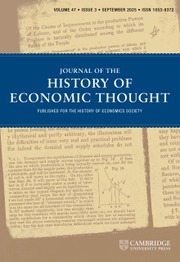Article contents
Early Doubts about the Phillips Curve Trade-Off
Published online by Cambridge University Press: 11 June 2009
Extract
The language of graphical analysis has an immediacy which has proven potent in the dissemination of economic ideas (Solow, 1987, p. 186). J. M. Keynes' General Theory of Employment, Interest and Money contained only one diagram (Keynes, 1936, p. 180), but J. R. Hicks' graphical IS/LM analysis contributed to the popularization of one interpretation of Keynes' message. Paul Samuelson's textbook used many graphs, which may account, in part, for its pedagogical irresistibility (Elzinga, 1992, p. 863). Two graphs, named after A. W. H. Phillips and Arthur Laffer respectively, became particularly influential in post-1960 policy debates. The “theoretical Phillips curve” (Phillips, 1953, p. 31; 1954, p. 308) was of interest mainly to specialists in optimal control theory; and Phillips' second empirical curve (Phillips, 1959) remained unpublished for almost four decades. Yet his first empirical curve (1958) led to policy implications which were accepted by virtually an entire scientific profession almost instantaneously, “with alacrity” (Friedman, 1977, p. 469). It appeared to fill a gap in the Keynesian neoclassical synthesis, and was rapidly adopted by the textbook writers (Samuelson, 1961, p. 383; Lipsey, 1963, p. 438). During the 1960s, it became widely accepted that ongoing inflation would be accompanied by a sustained reduction in unemployment. When inflation came to be associated with increasing rates of unemployment, this reflected adversely on the economics profession in general, and Keynesian economics in particular.
Information
- Type
- Articles
- Information
- Copyright
- Copyright © Cambridge University Press 1998
References
REFERENCES
- 8
- Cited by

